Introduction
The third part in our series on kids and guns is going to address teaching. When do we teach kids about guns? Why should we teach them? What should we teach them? All the basic questions about kids and guns that we need to ask and answer.
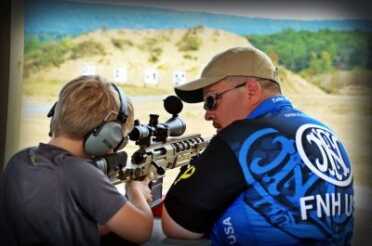
FN America’s Tabor Bright, working with a junior shooter at a side match event. Side matches are events incorporated into competitions, designed to both showcase guns and introduce new shooters in a friendly, one-on-one environment.
The Series
- The Basics
- Storage
- Teaching
- Rimfire
- Hunting
- Competitive Shooting
- Shotguns
- Pistols
- Revolvers
- Older kids
- Tactical Kids
How I Grew Up
I grew up the way many of you likely did, which is to say guns were a part of my day-to-day life. They were in the gun cabinet, stored in the safe, over the mantel of the fireplace, basically, all around the house.
But for many out there, I recognize that guns are not woven into the fabric of their lives, to borrow a refrain from that old cotton commercial. Unlike myself, those unfamiliar with firearms may never consider buying one for a son or daughter’s birthday or as a keepsake wedding gift. These folks may even see guns as dangerous and unnecessary.
Yet, I am of the opinion that every child should learn basic gun safety, even if their parents are staunch gun-control proponents. Why do I believe this? Why should every child be educated on how to safely and responsibly use firearms?
Why Teach Guns?
“If a nation expects to be ignorant and free… it expects what never was and never will be.” — Thomas Jefferson
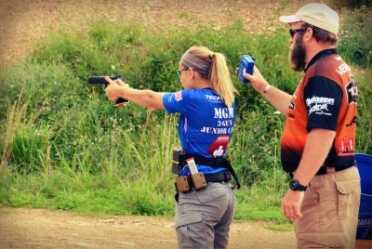
Dean DeTurk, instructing at the MGM Junior camp while Katie Francis shoots pistol.
I’m going to start first with the “why.” Why we can’t foster ignorance. Why every child should be taught what a firearm is and how to use it. The main reason is safety.
We teach kids about fire, and have fire drills, but we still let them use the stove. We teach them about the dangers of drowning, yet they can still enjoy swimming in a pool. We teach them not to play in the street, but we still let them drive cars when they turn 16.
My point is there are many tools and resources in our lives that require teaching in order for one to safely coexist with them. Even if a child doesn’t pump gas at the gas station, they know not to light matches around a gas pump. It’s common sense and basic safety. Guns are another tool. A tool for good; to help us hunt and eat, to help us farm and protect livestock, to help police and military do their jobs. They’re also a tool for sport and fun. When you think about it, guns have as much necessity as do power tools, cars, pools, gas, electricity. They’re inventions that have made our lives better, but they do hold power. A power that must be both respected and protected.
Elephants Never forget!
Respected and protected. That’s the elephant in the room for most people who don’t hold guns in a positive regard. They might recognize the power of a firearm out of a sense of fear but not place it in the proper context so they can respect both what that power can do physically, and what that power stands for. The potential power of firearms and the potential power they hold is not just in the single round each is capable of firing, it is in the potential that all guns and gun owners collectively represent.
Coming to grips with that potential power is what is at the heart of our country’s struggle with firearms ownership. People who oppose guns look only at the power they fear and not at the power they represent. Our very existence as a nation was basically purchased with musket balls and blackpowder. We can’t cover up that truth no more than we can cover up the graves in Arlington of those who fought and died for it. And when we stop respecting the purchase of freedom made by our forefathers, we are in danger of losing that freedom.
When Americans, as a collective, hold in high regard the power to arm and protect themselves from those who would take their freedoms, we are recognizing and honoring our history. Teaching our children about that history is part of educating them about firearms. It doesn’t have to be a lesson in tyranny and philosophy, but a simple explanation that while we have tools that make life better, those same tools also made this life possible, which is a life free from oppression and suffering, a life people in other parts of the world still do not have. Freedom and peace were purchased at a price and if we forget that, we fail not only our children but those who gave their lives to build our country and to make this world a better place.
So do not forget where your freedom came from. Even if you don’t own a gun, your freedom was fought for with one and defended by one. And you owe it to your children to teach them history, to teach them why people were able to carve out a life and build a country that has used that freedom to help others in need, to keep not only us free but to free oppressed people all over the world.
Curiosity And Cats… Kids Are NOT Cats!
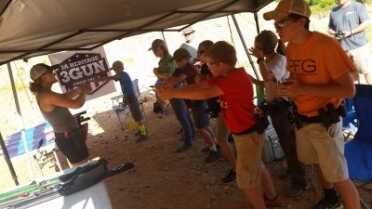
Lena Miculek, instructing juniors on the finer points of how to properly grip a pistol at the 2A Heritage Junior Camp.
While you owe it to your kids to give them a foundation on which to build an understanding of gun ownership, to teach them history, they’re not going to retain much if it’s boring. Books get boring, and sooner or later kids are going to ask about the guns in the safe, not just the ones in books. That’s why we need to teach them.
When children are old enough to start asking about guns, it’s an appropriate time to start teaching safety. Kill the curiosity by satisfying it. Be careful that you’re not teaching a toddler how to access your safe, watch them like a hawk, but show them safe firearms handling skills. Teach them that they need to make sure a firearm is unloaded before they handle it, along with the other basic rules. Teach them that it’s like checking both ways before they cross the street. It should be so second nature, we shouldn’t have to say it. You should recite the rules as you access guns when kids are around. Make them hyper-aware of what you are doing, what is happening, and why you’re doing it.
Kids need recitation. Malcom Gladwell’s book “The Tipping Point” highlights the need for an idea to reach a saturation point before it takes hold. And safety rules are similar. You need to repeat them until they are not just memorized in your head, but in your actions. The entire educational model of some curriculums in teaching builds off repetition, and children need it. They might hear you say something 1,000 times before they really understand it. But a very basic model I use in teaching is: 1. Tell them what you are going to teach them, 2. Teach it to them, and 3. Tell them what you taught them. So every lesson has, in a sense, three repetitions. Even if you don’t own a gun, you should learn how to handle or be around them safely. You might not drive a car, but you know not to run into traffic. Guns should be given that same respect.
Those who teach shooting and firearms safety tend to hold strong beliefs. One of the instructors I’ve worked with at junior camps, Larry Houk, says that he believes “the one thing that can be taught early is take the curiosity out of it. Kids by nature are curious, it’s how they learn and if they are told ‘you can’t see it or touch it’, they will then attempt to find the time when you are not around to certainly check it out.”
So, to answer the “why” – it’s about fulfilling curiosity. Parent, instructor, and professional shooter Tommy Thacker says that “for those who are just curious…you fulfill that need, then they are finished. There is no need to search them(guns) out and figure it out on their own. For those who want more it is the early introduction that sets them up for future growth and development in the shooting sports. Earlier the better.”
“But Mom, Mom, Mom…When Mom?”
So we’ve got the why down but what about the “when,” more specifically, “what age”?
Again, parents who are passionate enough to instruct children in firearms safety have some answers for us. Tommy says that the “when is very subjective and I don’t think there is a clear cut age answer here. I believe this one revolves around the child and their overall level of development and practical understanding of what is involved with firearms. With my kids I had one that was ready to learn a great deal by 4 and then another that I didn’t want to do anything past safety and ‘curiosity removal’ as Larry stated until 6. I personally believe early safety and familiarity will be beneficial to all children. I grew up with firearms safety and hunting safety as a part of health class. This is how it should be. ”
And guns in schools is not something that’s a phenomenon of the distant past. I competed in smallbore rifle (late 80’s/early 90’s) and we went to high schools and shot events in gyms. Fast forward to 2016 and everyone’s read stories about kids being sent home from school for pretending to play with a gun, but what if we put our sanity goggles on, and asked a few questions. For example, what if a kid pretend-plays they’re baking with a gas stove. What, oh yeah, we call that make believe, and we encourage it!
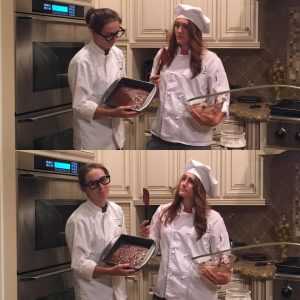
Professions: Why shouldn’t aspiring to be a professional shooter be as normal as a chef? Shooters, Lena Miculek and Ashley Rheurk hamming it up the night before a big match.
How about make believing they’re a race car driver? Yep, we’d allow that but cars kill every day. They are much more likely to injure your child than a gun, but you send them to classes to learn about them before you let them drive. So why isn’t firearms education mandatory in schools? Why do we have schools teaching welding and drivers ed., but not firearms safety? I believe it’s a mistake for schools to pick and chose which tools it teaches – to ignore some while focussing to extremes on others. It’s creating a warped sense of reality, building generations of youth who can tell you that they have the right to say whatever they want, but don’t understand the tools that were used to secure and defend that right.
Make believing is one of the markers of children’s psychological development. An ability to pretend play shows they’re able to process real vs. not real; it’s a way to work through situations, to prep for life. Don’t take my word on it, I spent time doing research under professors in college, one who has years of research on the subject of imagination and healing, and in his writing, Dr. Anees Sheikh draws out one key point on this subject – if your child can pretend play about real world situations, they’re building and testing a framework to process and deal with life.
So make-believe play, whether with toy cars, toy stoves, guns, it’s all part of life and the tools we come across in it.. Those Nerf guns kids love, my boys used them as a way of introducing firearms safety. They learned about not pointing it at anything they don’t want to hurt. You can teach basic firearms safety concepts. Retired Tulsa, OK police officer Dianna Muller says that toy guns can serve a purpose. Kids can learn how to “Keep your finger off the trigger, don’t point it at people.” You still need to figure out an appropriate age to start expecting them to be conscientious of it, but it’s a good place to start and determine if they are ready to head to the range.
Recipe for Success
So we’re through the why and when, but now we need to discuss the “how”?
First, figure out the goal. If it’s just to make sure the kids are comfortable, safe, and able to handle being around guns, then lots of talking, lots of incorporating firearms safety into everyday life. You need them to know what to do when they encounter guns, and how to be safe when they do. While you might teach them safe handling skills from early on, others might not. So one of your goals should be to give them a solid framework for keeping not only themselves safe, but those around them.
After decades of shooting, and participating in action shooting sports, I firmly believe that exposure to guns in competition is a valuable teaching tool, with so many safety layers built in, that if your kids took part, for even a short time, their gun handling skills would become cemented as lifelong habits.
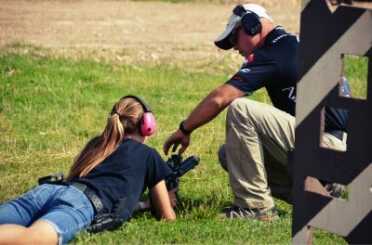
Armalite shooter, Greg Jordan, instructing a young shooter on shooting rifle from prone.
But again, don’t take my word, police officer and instructor, Greg J., says that “In my opinion giving kids a hands-on approach with knowledgeable instructors is the best way to teach firearms safety and responsible handling. This is a life long lesson they can pass on.” And he even suggests competition as a means of making gun safety interesting:
“One thing in common with all the shooting sports is safety. This can sometimes be a tough topic to capture an audience’s attention. With competition serving as the motivator for the kids, it makes learning safe firearms handling necessary and more appealing.”
While the how of teaching kids about guns changes with who and why we want to teach, there are some constants that can help, constants such as a focus on responsibility and safety, and the goal of establishing in children’s minds the fact that guns are powerful and need to be treated with respect. Parent, competitive shooter, Tommy Thacker has a few tips on how:
“How is again subjective but the lighter the recoil and report the better. I prefer to stay away from anything that looks like a game as I believe there needs to be a separation between the two. BB’s and all 22’s are great. I also like steel targets as kids seem to like instant feedback, keeps them interested longer.”

Instructor Tommy Thacker helping junior Dakota Overland understanding long range rifle holds during the 2A Heritage Junior camp. Photo Credit: Todd Overland.
Tommy is touching on the need to make sure children understand that while competition shooting can be looked at as a game, and there can be a lot of fun in it, there needs to be a separation when it comes to teaching: guns aren’t toys, and need proper respect. Kids can understand that, and we owe it to all children to teach it. This is something that transcends even gun-ownership Again, going back to cars and other tools, we have to be educated about things we meet in life, and guns are just another tool kids should understand.
Bringing it Full Circle
Shooting used to be common in public schools. New York state had more than 80 school districts with rifle teams in 1975. Safety with firearms wasn’t something that caused people worry, it was treated like any other activity that requires responsibility. And maybe that’s part of where the country took a wrong turn, we stopped expecting people to be personally responsible, and to treat children with the expectation that on serious subjects, they’re going to need to act like adults. We expect them to act like adults with cars, fire, pools, etc. — guns shouldn’t be any different.
In the end, we need to look at guns from more than one perspective. We need to consider them from the eyes of a child full of curiosity and wonder, from the eyes of a parent responsible for protecting children, and from the eyes of Americans with a duty to teach our heritage and history to our children and future generations.
###
About the author: Becky Yackley has been shooting competitively since she began as a teenager with service rifle and smallbore. She’s lived near the typical Marine Corps bases and spent 10 years near DC while her husband was active duty, but has settled into Wisconsin and shooting 3 Gun, USPSA, and Bianchi pistol with her three boys and husband. An avid runner and outdoorswoman, she shoots guns and photos, and sometimes her mouth…which her friends often remind her keeps them “alert” at late hours on road trips. Never known for being quiet, she’s bringing her brand of humor our way this year in hopes of sharing her love for shooting sports with our readers.

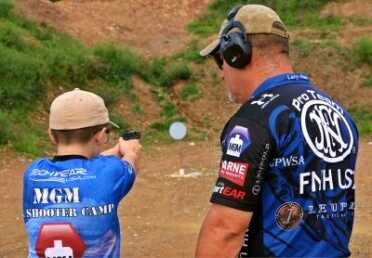
An avid shooter, 2nd Amendment supporter & retired US Marine, I must say the recent spate of accidental shootings by children, even toddlers, is extremely disturbing. Aside from the obvious tragedy of lives lost, bodies maimed and lives ruined, the danger to all law abiding well meaning and responsible gun owners is endangered with every unnecessary gun accident that occurs and tripled when minors are victims or involved.
We must all take extra care to keep our guns secured from access to all those who for any reason should not have access to them. Quick access secure storage is now affordable to anyone who can afford a firearm. Leaving guns unattended, unsecured or accessible for even a moment when children are or could be around is dangerous and irresponsible.
The accidents involving children shooting their parents during a planned shooting event is outrageous. Some children are too young to handle a gun regardless of parental involvement. If we aren’t physically controlling the gun, we are creating an opportunity for tragedy and even if we are, some children just aren’t ready or able to properly, knowingly and intelligently handle, possess or fire a gun.
Some will argue and call me names but the news this past two weeks is full of these tragic events, all of which could and should have been prevented.
Each time one of these incidents happen responsible gun owners come closer to losing their Second Amendment rights. Gun owners not only have a responsibility to their families, they have one to the gun community at large and to the preservation of our Second Amendment rights.
Brass, I’m not sure what incidents you are referring to when you say: “The accidents involving children shooting their parents during a planned shooting event is outrageous.” Maybe you can tell us what you are referring to?
As for children being able to control a gun, that’s something a parent needs to ascertain on a case-by-case basis, but there are youngsters and teens campable of winning world chanpionships and handling firearms much safer than many adults – including mlitary and police.
Amen, Becky! Doubtless, an adult needs to have a very solid appreciation of gun safety before training children and determining if they are safe. However, as you mentioned, there are many youngsters out there who know a lot more about gun safety than many cops.
Lol, thanks, but know I’m not knocking cops in general, my husband is one… 🙂 i just think it’s a very broad and inaccurate statement to blanket all children under assumptions based on size and perceived understanding.